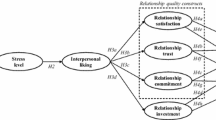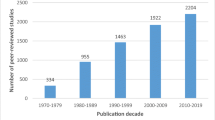Abstract
Researchers have long recognized that individuals in stressful marketing roles find ways to cope with organizational role stress. This study examines the effects of three psychological coping strategies—intrinsic motivational orientation, perceived role benefits, and psychological withdrawal—in a model of organizational role stress. Results indicate that intrinsic motivational orientations reduce perceptions of role conflict and role ambiguity, and increase job satisfaction; that perceived role benefits positively influence job satisfaction; and that job dissatisfaction is the primary cause of psychological withdrawal. The study supports the importance of coping efforts in models of organizational role stress among marketing personnel.
Similar content being viewed by others
References
Anderson, James C. and David W. Gerbing. 1988. “Structural Equation Modeling in Practice: A Review and Recommended Two-Step Approach.”Psychological Bulletin 103 (May): 411–423.
Bagozzi, Richard P. 1978. “Salesforce Performance and Satisfaction as a Function of Individual Difference, Interpersonal, and Situational Factors.”Journal of Marketing Research 15 (November): 517–531.
Beehr, Terry A. and Nina Gupta. 1978. “A Note on the Structure of Employee Withdrawal.”Organizational Behavior and Human Performance 21 (February): 73–79.
Behrman, Douglas N. and William D. Perreault, Jr. 1984. “A Role Stress Model of the Performance and Satisfaction of Industrial Salespersons.”Journal of Marketing 48 (Fall): 9–21.
Burke, Ronald J. and Monica L. Belcourt. 1974. “Managerial Role Stress and Coping Responses.”Journal of Business Administration 5 (Spring): 55–68.
Burke, Ronald J. and Tamara Weir. 1980. “Coping With the Stress of Managerial Occupations.” InCurrent Concerns in Occupational Stress. Eds. Cary L. Cooper and Roy Payne. London: John Wiley & Sons, 299–335.
Burt, Robert S. 1976. “Interpretational Confounding of Unobserved Variables in Structural Equation Models.”Sociological Methods and Research 5 (August): 3–52.
Churchill, Gilbert A., Jr., Neil M. Ford, Steven W. Hartley, and Orville C. Walker, Jr. 1985. “The Determinants of Salesperson Performance: A Meta-Analysis.”Journal of Marketing Research 22 (May): 103–118.
Darden, William R., Ronald Hampton, and Earl W. Boatwright. 1987. “Investigating Retail Employee Turnover: An Application of Survival Analysis.”Journal of Retailing 63 (Spring): 69–88.
Darden, William R., Ronald Hampton, and Roy D. Howell. 1989. “Career Versus Organizational Commitment: Antecedents and Consequences of Retail Salespeoples’ Commitment.”Journal of Retailing 65 (Spring): 80–106.
Deci, Edward L. 1972. “The Effects of Contingent and Noncontingent Rewards and Controls on Intrinsic Motivation.”Organizational Behavior and Human Performance 8 (October): 217–229.
Deci, Edward L. and Richard M. Ryan. 1985.Intrinsic Motivation and Self-Determination in Human Behavior. New York: Plenum Press.
Donnelly, James H., Jr. and John M. Ivancevich. 1975. “Role Clarity and the Salesman.”Journal of Marketing 39 (January): 71–74.
Edwards, Jeffrey R. 1992. “A Cybernetic Theory of Stress, Coping, and Well-Being in Organizations.”Academy of Management Review 17 (April): 238–274.
Fisher, Cynthia D. and Richard Gitelson. 1983. “A Meta-Analysis of the Correlates of Role Conflict and Ambiguity.”Journal of Applied Psychology 68 (April): 320–333.
Fiske, Susan T. and Shelley E. Taylor. 1984.Social Cognition. New York: Random House.
Folkman, Susan and Richard S. Lazarus. 1980. “An Analysis of Coping in a Middle-Aged Community Sample.”Journal of Health and Social Behavior 21 (September): 219–239.
Ford, Neil M., Orville C. Walker, Jr., and Gilbert A. Churchill. 1975. “Expectation-Specific Measures of the Intersender Conflict and Role Ambiguity Experienced by Industrial Salesmen.”Journal of Business Research 3 (April): 95–110.
Ford, Neil M., Orville C. Walker, Jr., and Gilbert A. Churchill. 1976. “The Psychological Consequences of Role Conflict and Ambiguity in the Industrial Salesforce.” InSales Force Performance. Eds. Neil M. Ford, Gilbert A. Churchill, and Orville C. Walker. Lexington, MA: Lexington Books, 35–48.
Fry, Louis W., Charles M. Futrell, A. Parasuraman, and Margaret A. Chmielewski. 1986. “An Analysis of Alternative Causal Models of Salesperson Role Perceptions and Work-Related Attitudes.”Journal of Marketing Research 23 (May): 153–163.
Good, Linda K., Grovalynn F. Sisler, and James W. Gentry. 1988. “Antecedents of Turnover Intentions Among Retail Management Personnel.”Journal of Retailing 64 (Fall): 295–314.
Goode, William J. 1960. “A Theory of Role Strain.”American Sociological Review 25 (August): 483–496.
Goolsby, Jerry R. 1992. “A Theory of Role Stress in Boundary Spanning Positions of Marketing Organizations.”Journal of the Academy of Marketing Science 20 (Spring): 155–164.
Hall, Douglas T. 1972. “A Model of Coping with Role Conflict: The Role Behavior of College Educated Women.”Administrative Science Quarterly 16 (December): 533–547.
Hayduk, Leslie A. 1987. InStructural Equation Modelling With LISREL. Baltimore, MD: Johns Hopkins University Press, 166–172.
Hirschman, Elizabeth C. 1981. “An Exploratory Comparison of Decision Criteria Used by Retail Buyers.” InRetail Patronage Theory. Eds. Robert F. Lusch and William R. Darden. Norman, OK: University of Oklahoma Printing Services, 1–5.
Jackson, Susan E. and Randall S. Schuler. 1985. “A Meta-Analysis and Conceptual Critique of Research on Role Ambiguity and Role Conflict in Work Settings.”Organizational Behavior and Human Decision Processes 36 (August): 16–78.
Johnston, Mark W., A. Parasuraman, Charles M. Futrell, and William C. Black. 1990. “A Longitudinal Assessment of the Impact of Selected Organizational Influences on Salespeople’s Organizational Commitment During Early Employment.”Journal of Marketing Research 27 (August): 333–344.
Joreskog, Karl G. and Dag Sorbom. 1988.LISREL 7 User’s Guide. Uppsala, Sweden: University of Uppsala.
Kahn, Robert L., Donald M. Wolfe, Robert P. Quinn, J. Diedrick Snoek, and Robert Rosenthal. 1964.Organizational Stress. New York: John Wiley & Sons.
Kohli, Ajay K. 1985. “Some Unexplored Supervisory Behaviors and Their Influence on Salespeople’s Role Clarity, Specific Self-Esteem, Job Satisfaction, and Motivation.”Journal of Marketing Research 22 (November): 424–433.
Kumar, Ajith and William R. Dillon. 1987a. “The Interaction of Measurement and Structure in Simultaneous Equation Models with Unobservable Variables.”Journal of Marketing Research 24 (February): 98–105.
Kumar, Ajith and William R. Dillon. 1987b. “Some Further Remarks on Measurement-Structure Interaction and the Unidimensionality of Constructs.”Journal of Marketing Research 24 (November): 438–444.
Latack, Janina. 1986. “Coping With Job Stress: Measures and Future Directions for Scale Development.”Journal of Applied Psychology 71 (June): 377–385.
Lazarus, Richard S., James R. Averill, and Edward M. Opton, Jr. 1974. “The Psychology of Coping: Issues of Research and Assessment.” InCoping and Adaptation. Eds. George V. Coehlo, David A. Hamburg, and John S. Adams. New York: Basic Books, 249–315.
Lazarus, Richard S. and Susan Folkman. 1984.Stress, Appraisal, and Coping. New York: Behavioral Science Books.
Locke, Edwin. 1976. “The Nature and Causes of Job Satisfaction.” InHandbook of Industrial and Organizational Psychology. Ed. Marvin D. Dunnette. Chicago: Rand-McNally, 1291–1349.
Lysonski, Steven. 1985. “A Boundary Theory Investigation of the Product Manager’s Role.”Journal of Marketing 49 (Winter): 26–40.
Maslach, Christina. 1982.Burnout: The Cost of Caring. Englewood Cliffs, NJ: Prentice-Hall.
McGrath, Joseph E. 1976. “Stress and Behavior in Organizations.” InHandbook of Industrial and Organizational Psychology. Ed. Marvin D. Dunnette. Chicago: Rand-McNally, 1351–1395.
Michaels, Ronald E., Ralph L. Day, and Erich A. Joachimsthaler. 1987. “Role Stress Among Industrial Buyers: An Integrative Model.”Journal of Marketing 51 (April): 28–45.
Miles, Robert H. 1980. “Organization Boundary Roles.” InCurrent Concerns in Occupational Stress. Eds. Cary L. Cooper and Roy Payne. London: John Wiley & Sons, 61–96.
Mobley, William H. 1977. “Intermediate Linkages in the Relationship Between Job Satisfaction and Employee Turnover.”Journal of Applied Psychology 62 (April): 237–240.
Mobley, William H., Roger W. Griffeth, H. H. Hand, and B. M. Meglino. 1979. “Review and Conceptual Analysis of the Employee Turnover Process.”Psychological Bulletin 86 (May): 493–522.
Muliak, Stanley A., Larry R. James, Judith Van Alstine, Nathan Bennett, Sherri Lind, and Dean C. Stilwell. 1989. “Evaluation of Goodness-of-Fit Indices for Structural Equation Models.”Psychological Bulletin 105 (May): 430–445.
Netemeyer, Richard G., Mark W. Johnston, and Scot Burton. 1990. “Analysis of Role Conflict and Role Ambiguity in a Structural Equations Framework.”Journal of Applied Psychology 75 (April): 148–157.
Nunnally, Jum C. 1978.Psychometric Theory, Second edition. New York: McGraw-Hill.
Osipow, Samuel H. and Anne S. Davis. 1988. “The Relationship of Coping Resources to Occupational Stress and Strain.”Journal of Vocational Behavior 32 (February): 1–15.
Osipow, Samuel H., Richard E. Doty, and Arnold R. Spokane. 1985. “Occupational Stress, Strain, and Coping Across the Life Span.”Journal of Vocational Behavior 27 (August): 98–108.
Pearlin, Leonard I. and Carmi Schooler. 1978. “The Structure of Coping.”Journal of Health and Social Behavior 19 (March): 2–21.
Pittman, Thane S., Jolee Emery, and Ann K. Boggiano. 1982. “Intrinsic and Extrinsic Motivational Orientations: Reward-Induced Changes in Preference for Complexity.”Journal of Personality and Social Psychology 42 (May): 789–797.
Pruden, Henry O. 1969. “Interorganizational Conflict, Linkage, and Exchange: A Study of Industrial Salesmen.”Academy of Management Review 12 (September): 339–350.
Pruden, Henry O. and Richard M. Reese. 1972. “Interorganization Role-Set Relations and the Performance and Satisfaction of Industrial Salesmen.”Administrative Science Quarterly 17 (December): 601–609.
Rosse, Joseph G. and Charles L. Hulin. 1985. “Adaptation to Work: An Analysis of Employee Health, Withdrawal, and Change.”Organizational Behavior and Human Decision Processes 36 (December): 324–347.
Rizzo, John R., Robert J. House, and Sidney I. Lirtzman. 1970. “Role Conflict and Ambiguity in Complex Organizations.”Administrative Science Quarterly 15 (June): 150–163.
Sarbin, Theodore and Vernon L. Allen. 1968. “Role Theory.” InThe Handbook of Social Psychology. Eds. Gardner Lindzey and Elliott Aronson. Reading, MA: Addison Wesley, 488–567.
Schuler, Randall S. 1986. “Organizational Stress and Coping: A Model and Overview.” InHandbook of Organizational Stress Coping Strategies. Eds. Amarjit Sethi and Randall Schuler. Cambridge, MA: Ballinger Publishing, 35–67.
Sheldon’s Retail Directory of the United States and Canada. 1987. Fairview, NJ: Sheldon, Phelon and Marsar Inc., 7–528.
Sieber, Sam D. 1974. “Toward a Theory of Role Accumulation.”American Sociological Review 39 (August): 567–678.
Spiro, Rosann L. and Barton A. Weitz. 1990. “Adaptive Selling: Conceptualization, Measurement, and Nomological Validity.”Journal of Marketing Research 27 (February): 61–69.
Teas, Kenneth. 1983. “Supervisory Behavior, Role Stress, and the Job Satisfaction of Industrial Salespeople.”Journal of Marketing Research 20 (February): 84–91.
Van Sell, Mary, Arthur P. Brief, and Randall S. Schuler. 1981. “Role Conflict and Role Ambiguity: Integration of the Literature and Directions for Future Research.”Human Relations 34 (February): 43–71.
Walker, Orville C., Gilbert A. Churchill, Jr., and Neil M. Ford. 1972. “Reactions to Role Conflict: The Case of the Industrial Salesman.”Journal of Business Administration 3 (Spring): 25–36.
Walker, Orville C., Gilbert A. Churchill, Jr., and Neil M. Ford. 1975. “Organizational Determinants of the Industrial Salesman’s Role Conflict and Ambiguity.”Journal of Marketing 39 (January): 32–39.
Wanous, John P. 1974. “A Causal-Correlation Analysis of the Job Satisfaction and Performance Relationship.”Journal of Applied Psychology 59 (April): 139–144.
Wingate, John W. and Joseph S. Friedlander. 1978.The Management of Retail Buying. Englewood Cliffs, NJ: Prentice-Hall.
Author information
Authors and Affiliations
Additional information
Dr. Keaveney’s research interests focus on retailing issues including retail buyer behavior, retail store image, and retail price promotions. Dr. Keaveney has also published in the areas of marketing organizational behavior, services marketing, and international marketing. She is co-author with Philip R. Cateora ofMarketing: An International Perspective, which has been published both in English and in Japanese. Dr. Keaveney has published articles in theJournal of the Academy of Marketing Science, Journal of Retailing, Journal of Promotion Management, Journal of Marketing Channels, andJournal of Volunteer Administration.
Dr. Nelson’s research interests include topics in marketing research, consumer behavior, and advertising. He has published in theJournal of Marketing, Journal of Advertising, Journal of Business Research, Journal of Marketing Research, and serves as occasional reviewer to these publications as well as to theJournal of the Academy of Marketing Science. He teaches courses in marketing management, marketing research, and multivariate statistics.
Rights and permissions
About this article
Cite this article
Keaveney, S.M., Nelson, J.E. Coping with organizational role stress: Intrinsic motivational orientation, perceived role benefits, and psychological withdrawal. JAMS 21, 113–124 (1993). https://doi.org/10.1007/BF02894422
Issue Date:
DOI: https://doi.org/10.1007/BF02894422




